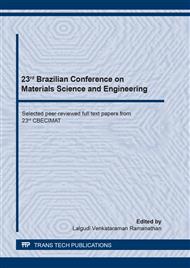
In order to minimize impacts caused to environment and to save natural resources, especially from non-renewable sources, recycling of polymeric materials has been object of study. In this scenery, are included elastomeric materials, such as rubber, especially used in tires manufacturing, considering that pneumatic industry consumes around 60% of rubber production. Taking into account that final tires destination is a requirement based on norms and national and international laws, this work aims to the development of a study on the efficacy of micro-wave irradiation in the process of de-vulcanization of tire powder to be used in recycling. Tire powder was subjected to micro-wave irradiation and further merged to SBR (butadiene-styrene rubber) polymeric matrix, at 5, 15, 25 phr; after mixture, resulting compound was characterized for evaluation of physico-chemical and mechanical properties. For the assessment of all samples containing SBR and rubber powder there were applied following essays: Infra-red spectroscopy (FTIR), Tensile strength and elongation at break, Swelling Index. It was verified higher values for mechanical properties imparted by an increased quantity of rubber powder incorporated to SBR matrix.
You might also be interested in these eBooks
Info:
© 2020 Trans Tech Publications Ltd. All Rights Reserved
[1]
M.A. Cimino, V.M. Zanta: Eng. Sanit. Ambiental Vol. 10 (4) (2005), p.299.
Google Scholar
[2]
Information on http://www.inicepg.univap.br/cd/INIC_2010/anais/arquivos/0908_0988_01.pdf.
Google Scholar
[3]
Information on http://www.anip.com.br/arquivos/f8201-white-book-versao-final.pdf.
Google Scholar
[4]
Reciclagem de Pneus: Análise do Impacto da Legislação Ambiental Através da Logística Reversa. pp.24-26.
DOI: 10.11606/t.3.2011.tde-09032012-140924
Google Scholar
[5]
C.H. ScuracchioI, D.A. WakiI, R.E.S. Bretas: Polímeros: Ciência e Tecnologia Vol. 16 (1) (2006), p.46.
Google Scholar
[6]
Annual Book of ASTM Standards. Standard Practice for Rubber-Materials, Equipament, and Procedures for Mixing Standart Compounds and Preparing Satndard Vulcanized Sheets, v. 09.01, 1996 (ASTM D-3182).
DOI: 10.1520/d3182-15
Google Scholar
[7]
Annual Book of ASTM Standards. Standard Test Methods for Vulcanized Rubber and Thermoplastic Test Methods for Vulcanized Rubber and Thermoplastic Rubber and Thermoplastic Elastomers – Tension, v. 09.01, 1996 (ASTM D-412).
DOI: 10.1520/d0412-06a
Google Scholar
[8]
Annual Book of ASTM Standards. Standard Test Method Rubber, Raw – Determination of Gel, Swelling Index, and Dilute Solution Viscosity, v. 09.01, 1996 (ASTM D-3616).
DOI: 10.1520/d3616
Google Scholar
[9]
S.A. Ghani, T.M. Madkour, H.M. Osman, A.R. Mohamed: Journal of Applied Polymer Vol. 81 (13) (2001), p.3169.
Google Scholar
[10]
Kiyan, L.Y. Aplicação da Radiação Gama Para Incorporação do Pó de Borracha em Formulações de Borracha EPDM e Nitrílica. Mestrado (Dissertação). São Paulo, 2001. Instituto Pesquisas Energéticas e Nucleares (IPEN/USP). SP.
DOI: 10.11606/d.85.2014.tde-24102014-132112
Google Scholar


